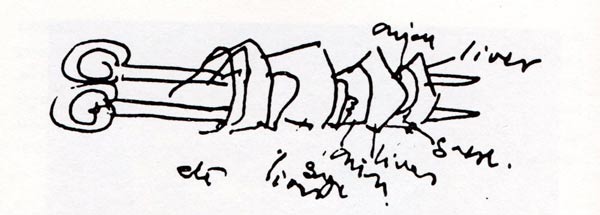David Garnett’s liver, sage & onion skuets
The terms ‘skuet’ and ‘skewer’ both derive from the Middle English ‘skuer.’ Logically enough a skuet is simply food cooked with a skewer. During the eighteenth century the most popular kind of skuet alternated sweetbreads, bacon and mushrooms, another felicitous combination. The skewer is a particularly good device for cooking something so delicate as offal, because by turning the food with wild or judicious abandon--either outlook will do--you control the level of heat that hits each part of the food. Figure on about ¼ pound of liver for each diner: You will need two skewers for each serving. Four servings.
- about 1 lb lamb, calve’ pork or chicken liver cut into uniform pieces of roughly an inch or more square
- a biggish sweet onion (like Vidalia) cut into tiles the same size as the liver
- lots of fresh sage leaves
- salt and pepper
___________________________________________________________________________
Garnett’s description of the recipe is skillful and succinct and requires scant elaboration:
“Alternate lumps of liver wit sage leaves plastered against and between them and onion--transfixed by two skewers. Thus
You use two skewers because if you use one the bits of liver slide round when you try to turn them over and cook the other side. The result is beyond the dreams of the greediest gastronome. The onion is half-raw. That makes it even better. The flavour of the sage is wonderful (You have to pick the sage leaves off the liver before you eat it.”
Notes:
-Garnett trusted his reader to season the skuets.
-People like their liver cooked from bloody to greyed. That makes this recipe particularly handy because everybody’s skuet can be “done to a turn.”
-He made his skuets with lamb’s liver, which can be difficult to find in the United States, but the other kinds listed are equally suitable.
-Sauce the skuets with Mrs. Grant’s eighteenth century “Sauce For Any Meat Broiled On Spits” if you like. The recipe, from The Receipt Book of Elizabeth Raper , appears elsewhere in the practical.


